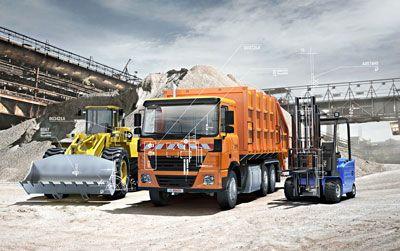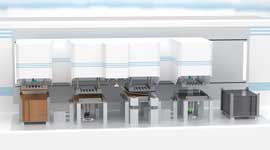Hybridization and fuel cells for off-highway propulsion
- Hits: 7914

Not only the future of the car, but also that of off-highway applications could be electric. This enables emission limits to be reached and, at the same time, an electrically powered machine, for example, significantly reduces the noise on a construction site. Bosch offers different components for an electric drive and combines the electric motor SMG180 / 120 and the inverter "Invcon 2.3" from the tried and tested high-volume technology from the car with an EDT180 reduction gear for drive transmission and special software for a complete drive system for off-highway applications.
The electric drive is particularly powerful: For acceleration or boost phases, the drive can generate peak power of up to 90 kW. The system is suitable in combination with an electric energy storage for the electrification of various applications in the off-highway market, even off the pure traction drive. In this case, a speed and a torque controlled operation is possible. A coupling with other units such as internal combustion engine or other transmissions such as axle or chain drives makes the system universally applicable. In particular, the representation of a serial hybrid based on hydrostatic systems is possible due to similar space and interface requirements with little effort.
Recuperative hybrid excavator
 Hybrids will gain significantly in weight in the future and electric drives will be used in the off-highway sector. One application example are robust systems that recover energy from braking the rotational movement. Recuperating hybrid excavators could therefore be used on construction sites in the future. Downsizing and downspeeding engines is also possible with the new technology.
Hybrids will gain significantly in weight in the future and electric drives will be used in the off-highway sector. One application example are robust systems that recover energy from braking the rotational movement. Recuperating hybrid excavators could therefore be used on construction sites in the future. Downsizing and downspeeding engines is also possible with the new technology.
This means that fuel savings of up to 40% are conceivable. The hybridization of heavy commercial vehicles therefore significantly increases profitability. Because fuel is the largest cost item when using heavy machinery. At the same time, the new hybrid technology supports future emission limit values: thanks to the low fuel consumption, the CO2Output lowered. The new drive is as usual powerful: the continuous power of the electric machine is 65 kW. In the short term, the power can also increase up to 120 kW, whereby a maximum torque of 1 000 Nm is achieved.
Electrified luggage tug
An electrified baggage tractor built as part of the publicly funded project "Innovative Regenerative On-Board Energy Converters" (Innorobe) now drives with a fuel cell as a range extender. Bosch Engineering supplies a key component of the fuel cell system with the "Fuel Cell Control Unit" (FCCU). This controls the entire system with an integrated hydrogen, air and coolant control. Bosch Engineering also took on other tasks within the project.
 Facts and components from and for battery production
Facts and components from and for battery production
The developers from Abstatt designed the fuel cell system to determine the dimensions of the components. To do this, they analyzed vehicle use, operating time, refueling and numerous other requirements in order to then determine parameters such as the battery size, the power of the fuel cell drive and the dimensions of the hydrogen tank. They set up the overall system and optimized the interaction of the components, including control and regulation. The developers used their own fuel cell laboratory and a test bench for a 20 kW fuel cell system for their tests.
Fuel cell control unit
 In factories in particular, locally emission-free mobility is already a reality - regardless of whether it is a forklift or a mini excavator. Accordingly, an infrastructure is already in place in many places: there are already more hydrogen filling stations at airports and other private company premises.
In factories in particular, locally emission-free mobility is already a reality - regardless of whether it is a forklift or a mini excavator. Accordingly, an infrastructure is already in place in many places: there are already more hydrogen filling stations at airports and other private company premises.
For locally emission-free construction machines, the manufacturer offers the key technology for the FCCU fuel cell drive. This component is the control center for fuel cell applications in the off-highway area. It is based on automotive technology that has been tested in series and controls the entire system with integrated hydrogen, air and coolant regulation.
The FCCU controls the tank shut-off valve, the pressure regulator and the vent valve in the hydrogen path. The hydrogen recirculation can be carried out either passively or actively. If required, the component can also take over communication with a gas station. The control unit provides the air in the air path with an electric compressormass flow a. The pressure can be selected via a throttle. The FCCU sets the optimum operating humidity for the membrane via a humidifier bypass. Another advantage for the manufacturer is that the control unit can be integrated particularly easily into a fuel cell system using a large number of analog and digital interfaces.
